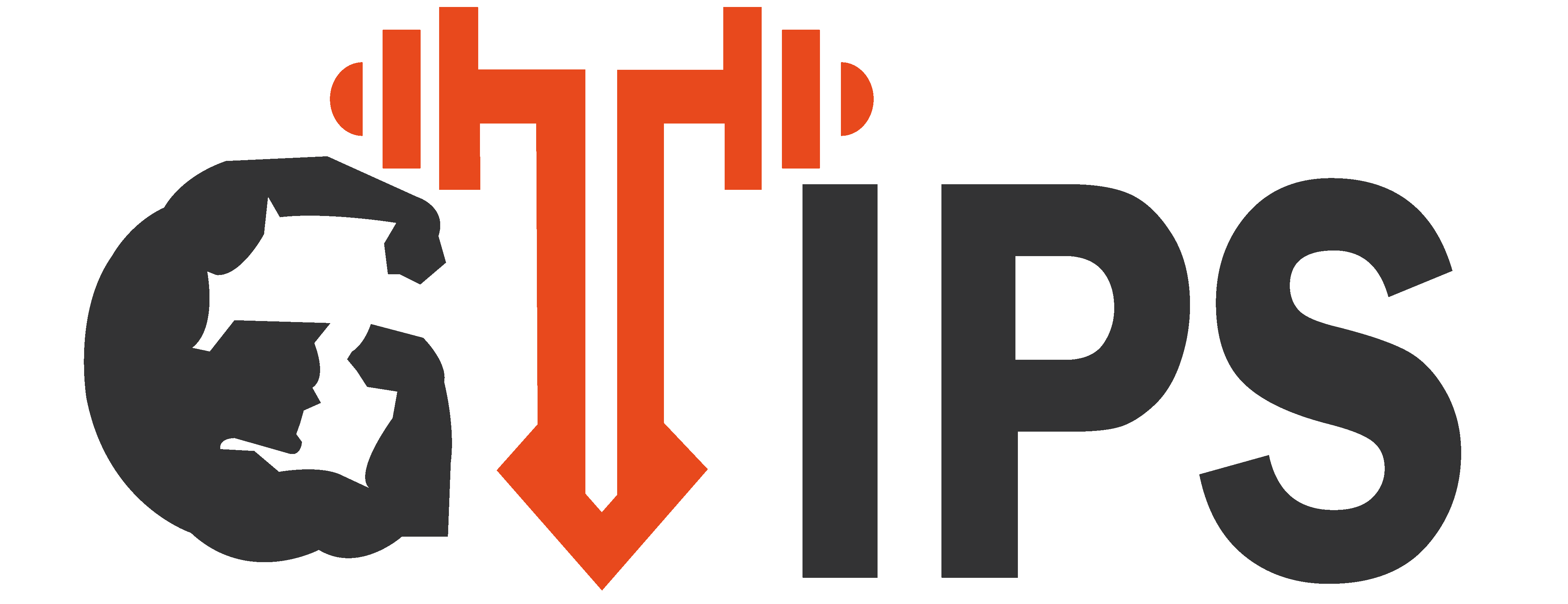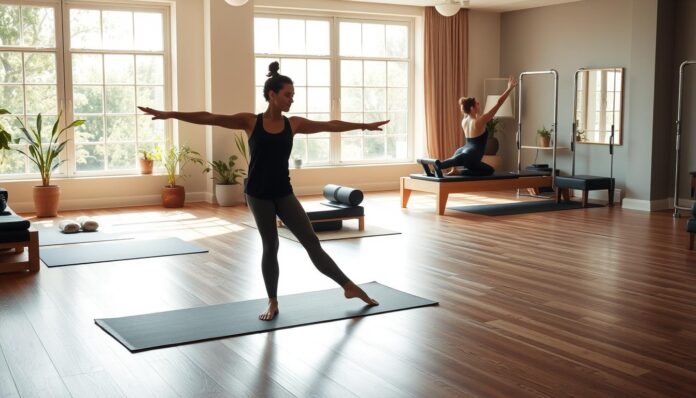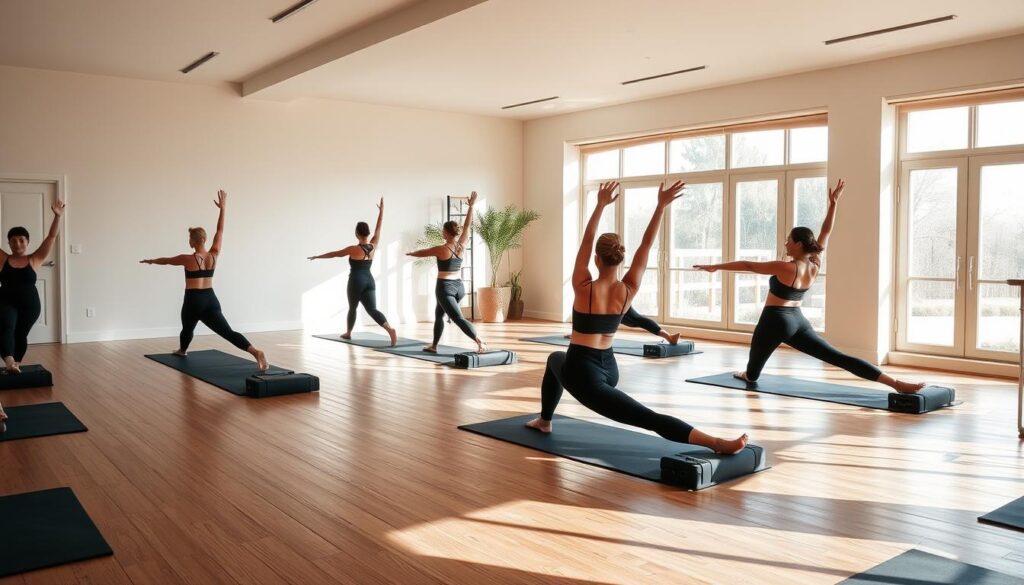Did you know the original 34 Pilates exercises are key to classical Pilates? Joseph Pilates created them, and they focus on the mind-body connection. He believed that “Contrology (his term for Pilates) begins with mind control over muscles.”
By doing these exercises in the right order, you get many benefits. You’ll see better flexibility, strength, and posture. Plus, you’ll feel more energetic and happy.
Key Takeaways
- The original 34 Pilates exercises are the foundation of classical Pilates.
- Pilates emphasizes the mind-body connection and performing exercises in a specific order.
- Pilates offers benefits such as increased flexibility, strength, injury prevention, and improved posture.
- Pilates exercises target smaller stabilization muscles, engaging the core from the inside out.
- Proper alignment and controlled breathing are key for effective Pilates practice.
Introduction to Classical Pilates
Joseph Pilates, the founder of classical Pilates, introduced his 34 Pilates exercises in the 1920s in New York City. He believed doing these “Contrology” exercises four times a week for three months could change your body and mind. It could also improve your spirit.
The Origins of Pilates
Pilates was passionate about fitness and healing because of his own health issues as a young man. He created a unique practice that connects body, mind, and spirit. It focuses on controlled breathing and precise movements.
Benefits of the Original 34 Pilates Exercises
- Increased flexibility and mobility
- Greater overall strength
- Injury prevention and rehabilitation
- Improved core strength
- Balanced muscular strength
- Enhanced posture
- Boost in energy and mood
These classical Pilates exercises can be done on a mat or with Pilates equipment like the Reformer. They suit different fitness levels and preferences.
“If you will faithfully perform your Contrology exercises regularly only four times a week for just three months as outlined in Return To Life, you will find your body development approaching the ideal, accompanied by renewed mental vigor and spiritual enhancement.”
– Joseph Pilates
Pilates Exercises Names
Pilates is known for its wide range of exercises. These exercises focus on the core, improve spinal mobility, and boost overall strength. The Pilates Hundred, Roll Up, and Roll-Over are among the most famous.
The Hundred
The Pilates Hundred is a classic exercise for strengthening the core. To do it, hold behind your knees, pull your belly in, and lower down to the floor. Lift your head and shoulders a bit while keeping your lower back on the floor.
Next, move your arms up and down at your sides. Breathe in for five counts and out for five, aiming for 100 pumps.
The Roll Up
The Roll Up enhances spinal mobility and flexibility. Begin by lying on your back with your legs together and arms up. Inhale as you lift your arms and head, curling your chest and pelvis up.
Exhale and roll up further, pausing when your shoulders are above your hips. Slowly roll back down, keeping control.
The Roll-Over
The Roll-Over targets the abdominal muscles and improves spinal mobility. Start by sitting tall with your hands on your shins or thighs and elbows wide. Bring your legs toward your chest, keeping your toes off the mat.
Inhale to roll back, then exhale and roll forward to the start. Keep a C-curve throughout.
These three exercises are part of the 34 original Pilates moves by Joseph Pilates. Mastering them can help you achieve a strong, flexible, and balanced body through Pilates.
Core Strengthening Movements
Pilates is famous for making your core muscles strong. This is key for good posture, balance, and stability. Two main Pilates moves are the Single Leg Circles and the Rolling Like a Ball.
Single Leg Circles
The Single Leg Circles exercise strengthens your core and boosts hip mobility. Start by lying on your back with one leg up and the other extended. Your lifted foot should be as if you’re balancing a book on it.
Inhale and move the lifted leg across your body, down, and around. Make the circle as big as you can while keeping your pelvis stable. Do five circles in one direction, then switch legs and repeat.
Rolling Like a Ball
The Rolling Like a Ball exercise is another core-strengthening move that tests your balance. Begin by sitting up straight in a slight C-curve. Place your hands on your shins or behind your thighs, with your elbows wide.
Bring your legs towards your chest, keeping your toes off the mat. Take a deep breath to roll back. Then, exhale and roll forward to your starting position, keeping the C-curve.
Both the Single Leg Circles and the Rolling Like a Ball exercises are great for building core strength. They also improve hip mobility and balance. These are vital for Pilates and everyday life.
Mat Work Essentials
Pilates mat work uses your body weight and a mat. It’s a key part of Pilates. These pilates mat work exercises help tone muscles, improve posture, and build core strength. They use controlled movements and precise form.
Important mat work exercises include the Pelvic Curl, Chest Lift, Spine Twist Supine, and Single Leg Stretch. These exercises target different muscles and improve balance and stability. They are the base of Pilates, focusing on your core and muscle toning.
The original Pilates mat exercise order comes from Joseph Pilates’ book ‘Return to Life’. It’s considered classical Pilates. Online Pilates Classes offers a 40-day trial for $40. It lets you start with their wide range of mat and reformer classes.
- The Pelvic Curl: Targets the glutes and hamstrings while improving spinal mobility.
- Chest Lift: Strengthens the abdominal muscles and improves posture.
- Spine Twist Supine: Works the obliques and improves spinal rotation.
- Single Leg Stretch: Challenges core stability and engages the hip flexors.
Adding these pilates mat work exercises to your routine can make your body strong, balanced, and aligned. It helps you move with confidence and grace.
Reformer Pilates Exercises
The Pilates Reformer is a special machine that makes pilates reformer exercises harder. It uses springs and pulleys. Two key exercises are The Teaser and the Leg Pull Down. They work on different muscles and boost your fitness.
The Teaser
The Teaser focuses on abdominal strength and flexibility. You start sitting on the Reformer with your legs out and arms forward. Then, you inhale and roll back, lifting your legs up.
Next, you exhale and roll back up. This exercise needs you to keep your core tight and in control.
Leg Pull Down
The Leg Pull Down targets lower body strength and core stability. You start by kneeling on the Reformer, rounding your back, and keeping your arms straight. Then, you push and pull your lower body back and forth.
This movement makes the Reformer platform slide a bit. It works your legs and keeps your core muscles active to stay stable.
Both the Teaser and Leg Pull Down are great pilates reformer exercises. They improve abdominal strength, flexibility, lower body strength, and core stability.
Mind-Body Connection in Pilates
Pilates focuses on the mind-body connection at its core. Joseph Pilates, the creator, said “Contrology begins with mind control over muscles.” This practice helps people connect their physical and mental sides deeply.
Controlled Breathing
Controlled breathing is key in Pilates. It helps people link their movements with their thoughts. This makes the mind-body experience better.
Deep, rhythmic breathing also boosts physical strength and flexibility. It also helps in relaxing and reducing stress.
Joseph Pilates Method
The Pilates method, created by Joseph Pilates, is about total wellness. It combines the body, mind, and spirit. Pilates thought physical fitness leads to happiness.
His exercises aim to improve well-being, not just strength. The method focuses on control and balance. It aims for the “complete coordination of body, mind, and spirit.”
“Contrology begins with mind control over muscles.”
Pilates helps people improve their physical and mental health. It uses controlled breathing and precise movements. This approach transforms wellness in a holistic way.
Conclusion
Pilates is more than just a workout. It combines body, mind, and spirit in a unique way. Joseph Pilates’s book “Return to Life” outlines 34 exercises at the heart of Pilates. These exercises focus on controlled breathing and precise movements.
Practicing Pilates on a mat or with equipment like the Reformer offers many benefits. You’ll see improvements in core strength and flexibility. It also helps prevent injuries and boosts mental well-being. However, it’s important to be mindful of the Pilates exercises benefits and risks, such as straining muscles or aggravating pre-existing conditions, especially if the exercises are not performed with proper form or under guidance.
The Reformer exercises are low-impact. They help improve stamina, posture, and reduce body tension. Adding Pilates exercises to your routine can make your body and mind stronger and more balanced.
Pilates covers a wide range of exercises, from the Short Box series to Rowing. It’s a holistic approach to wellness. It combines mind-body connection and low-impact workout principles. Start your Pilates journey for better physical and mental health.
FAQ
What are the original 34 Pilates exercises?
Joseph Pilates’s book “Return to Life” lists 34 Pilates exercises. These exercises are the heart of classical Pilates. They focus on the mind-body connection.
These exercises help you become more flexible and strong. They also prevent injuries and improve your posture. Plus, they can make you feel happier and more energetic.
What is the significance of the mind-body connection in Pilates?
Pilates is all about connecting your mind and body. Controlled breathing is key in this practice. Joseph Pilates thought that controlling your muscles starts with your mind.
He believed in focusing your mind during exercises. This focus is essential for Pilates.
What are some key Pilates mat work exercises?
Pilates mat work uses your body weight and a mat. It’s a core part of classical Pilates. Exercises like the Pelvic Curl and Chest Lift are important.
They work on different muscles and improve balance. The Single Leg Stretch is another key exercise.
What are some popular Pilates Reformer exercises?
The Reformer adds a challenge to Pilates with springs and pulleys. The Teaser is a famous exercise. It targets your abs and boosts flexibility.
The Leg Pull Down is another favorite. It strengthens your lower body and improves core stability.
What are the benefits of the Pilates method?
Joseph Pilates created a fitness method that’s holistic. It combines body, mind, and spirit. The goal is to achieve complete coordination.
Pilates focuses on precision and control. It aims to develop the whole body evenly. This approach is unique in fitness.





